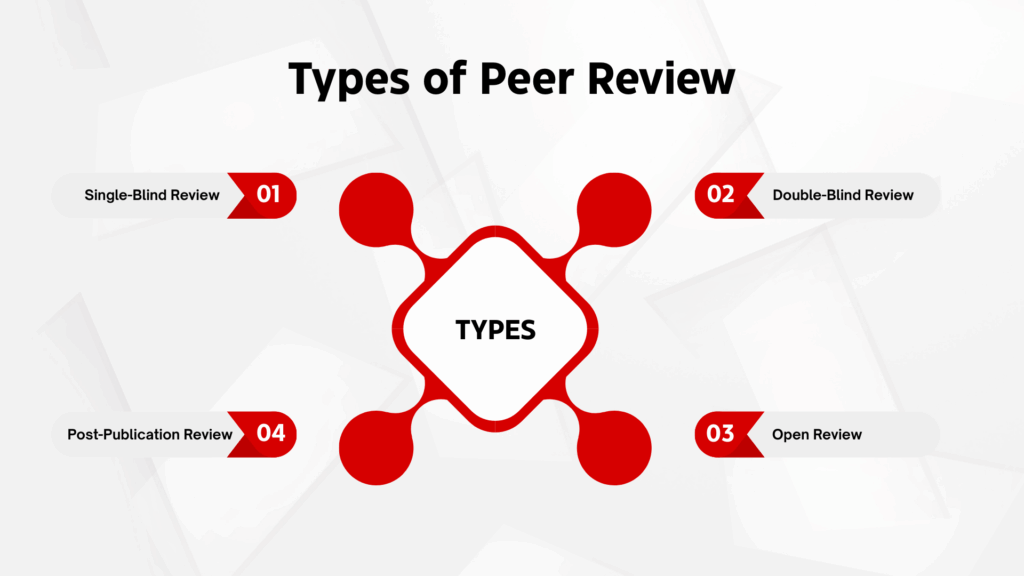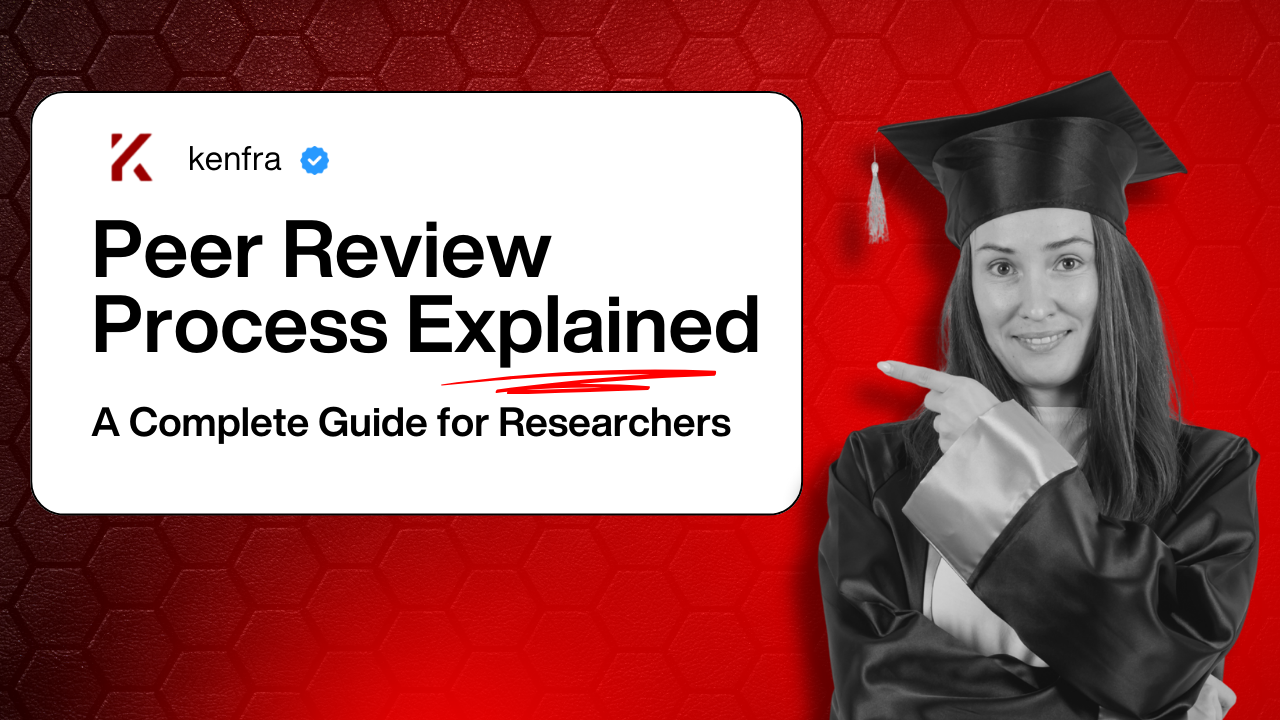Peer Review Process Explained: A Complete Guide for Researchers
Kenfra Research - Shallo2025-08-26T16:51:32+05:30When you submit your research paper to a journal, the next big step is the Peer Review Process. This is the stage where experts in your field carefully read, evaluate, and give feedback on your work before it is published. Learn the main causes of journal paper rejection and get expert tips to avoid mistakes for a successful publication.
In this blog, we will explain the peer review process in detail, its types, benefits, challenges, and tips to handle it successfully. Whether you are a first-time author or an experienced researcher, understanding how peer review works will help you prepare your paper better and increase your chances of acceptance.

What is Peer Review?
Peer review is a process where other researchers (peers) in the same field check your research paper to ensure it is original, valid, and useful. Think of it as a quality check before your work reaches the public.
Journals use peer review to make sure that only reliable and valuable research gets published. Reviewers provide constructive comments, suggest improvements, and sometimes recommend rejection if the paper does not meet the standards.
Why is Peer Review Important?
Peer review is not just a formality; it plays a key role in academic publishing. Here are the main reasons why it matters:
- Ensures Quality – Reviewers check if your work is accurate, clear, and backed by strong evidence.
- Detects Errors – Mistakes in methods, data analysis, or interpretation can be pointed out.
- Provides Feedback – Authors get expert suggestions to improve their work.
- Builds Trust – Published papers go through a strict process, which increases reader confidence.
- Prevents Plagiarism – Reviewers ensure the work is original and not copied.
Without peer review, research publishing would lose its credibility.

Types of Peer Review
Not all peer reviews are the same. Different journals use different models. The main types are:
- Single-Blind Review
- The reviewers know the author’s name, but the authors don’t know who reviewed their paper.
- Commonly used, but sometimes may lead to bias.
- Double-Blind Review
- Both authors and reviewers remain anonymous.
- Helps reduce bias based on gender, institution, or reputation.
- Open Review
- Both sides know each other’s identities.
- Sometimes, reviewer comments are published with the paper for transparency.
- Post-Publication Review
- Research is published first, and then readers and experts comment on it publicly.
- This is becoming popular with open-access journals.
Steps in the Peer Review Process
Let’s break down the peer review journey step by step:
Step 1: Submission
The author submits the manuscript to a journal. The paper must follow the journal’s guidelines in formatting, referencing, and structure.
Step 2: Editorial Check
The journal editor reviews the submission. If the paper is out of scope, poorly written, or has obvious flaws, it may be desk rejected without peer review.
Step 3: Reviewer Selection
Once the paper clears the initial check, the editor forwards it to two or more field experts for review.
Step 4: Review Process
Reviewers evaluate the paper by checking:
- Originality of the research
- Strength of methodology
- Accuracy of data and analysis
- Clarity of writing
- Significance of findings
They then submit a report with comments and recommendations.
Step 5: Editorial Decision
Based on the reviewers’ feedback, the editor makes a decision:
- Accept (rare in first submission)
- Minor Revision (small changes needed)
- Major Revision (significant changes required)
- Reject (not suitable for the journal)
Step 6: Revision and Resubmission
If revisions are requested, the author must improve the paper and resubmit it with a response letter explaining the changes made.
Step 7: Final Decision
After revisions, the editor takes the final call. If everything is satisfactory, the paper is accepted for publication.
Common Challenges in Peer Review
The peer review process is not always smooth. Authors may face several challenges:
- Long Waiting Periods – Sometimes, it takes months to get feedback.
- Harsh Criticism – Some reviewers may be too critical, which can be discouraging.
- Bias Issues – Reviewers may favor well-known authors or institutions.
- Rejections – Even good papers can get rejected if they don’t fit the journal’s scope.
How to Handle Peer Review Successfully
Facing peer review can feel stressful, but with the right approach, you can turn it into an opportunity for growth. Here are some tips:
- Choose the Right Journal – Select a journal that matches your research field.
- Follow Guidelines Strictly – Format, references, and word count must be correct.
- Be Open to Feedback – Treat reviewer comments as constructive, not personal.
- Reply Professionally – When revising, explain clearly how you addressed each comment.
- Stay Patient – The process takes time, but it improves the quality of your work.
Benefits of Peer Review for Authors
Even though it can be tough, peer review offers many advantages for researchers:
- Improves the clarity and strength of your work.
- Increases your chances of being recognized in the academic community.
- Helps you learn from experts in your field.
- Boosts your research credibility and career growth.
Future of Peer Review
With technology and open-access publishing, the peer review system is evolving. Some journals are adopting AI tools to check plagiarism and data accuracy, while others promote open peer review for transparency.
Despite its flaws, peer review remains the gold standard for academic publishing and is unlikely to be replaced anytime soon.
Conclusion
Academic publishing relies heavily on the Peer Review Process as its foundation. It ensures that only high-quality, trustworthy, and valuable research reaches the scientific community. For authors, the Peer Review Process may seem challenging, but it is also an opportunity to learn, improve, and grow as a researcher.
If you are preparing to submit your paper, understanding how peer review works will help you face the process with confidence. Remember: every revision and feedback brings your work one step closer to publication.
Need Help With the Peer Review Process?
Navigating the peer review process can feel overwhelming—but you don’t have to do it alone. At Kenfra, we guide PhD scholars and researchers through every step of academic publishing. From journal selection, plagiarism check, formatting, revisions, and responses to reviewers, our expert team ensures your research stands out.
Take the stress out of publishing—let Kenfra help you succeed.
Contact us today and make your research publication journey smooth and successful.








Leave a Reply